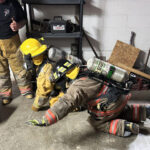The anatomy of knitting
FIBER ARTS
by Michele Goldman
Who taught you to knit? Your mother? Grandmother? The cultural background of whomever taught you determines the style of knitting you use.
Different cultures have evolved different ways of holding the needles and throwing the yarn. People of French ancestry tend to hold their right needle like a pencil with their forefinger on top, while throwing the yarn with the same finger. Those with an English background tend to hold one needle in each hand in an upright manner. They drop the right needle in order to pick up the yarn to throw it with the right hand. I was taught to knit by my Tante Judi, who was from Switzerland. Folks in that region, including Germany and Scandinavia, hold one needle in each hand, but wrap their working yarn around their left forefinger. This method is commonly called “continental,” referring to its dominance on the “continent” of Europe. Knitting this way requires much less movement of the hand — just a quick flick — so it’s faster with less stress on the wrist.
There are County residents of Norwegian descent and many of them knit in the continental manner, but they purl in a most unique way. It looks as if they’re about to knit again, but they make a downward scooping motion and somehow a purl stitch emerges.
One of the more interesting evolutions in knitting styles is found in parts of South America. They put a safety pin up on their shoulder and run their working yarn through it, creating tension on the yarn. They then knit and purl using their right thumb. Circular knitting is done wrong side out. It looks awkward, but they can knit at amazing speeds, necessary since many knitters in South America, especially among indigenous people, knit for profit.
Just as knitting styles emerge among different cultures, so do knitting patterns. The French are known for their lace knitting, the Irish for their cables, the Scandinavians for their color work. Fair Isle sweaters come from the southernmost island in the Shetlands, located roughly halfway between Scotland and Norway. The people of these islands, although long under the control of Scotland, feel most connected to their Norse heritage. Here’s a simple pattern that is associated with the Shetland isles, but is found in old French knitting books, as well. It’s an easy introduction to lace knitting. Enjoy!
A Lacy Scarf
On size 8 needles, cast on 65 stitches.
Row 1 – Knit 2, Knit 2 together, *Knit 3, Yarn over (YO), Knit 1, YO, Knit 3, Knit 3 together. Repeat from * to the last 11 stitches and then Knit 3, YO, Knit 1, YO, Knit 3, Knit 2 together, Knit 2.
Row 2 – Knit.
Continue by repeating rows 1 & 2 until your scarf is as long as you’d like.
Michele Goldman owns Fiberphilia yarn shop in Presque Isle.







